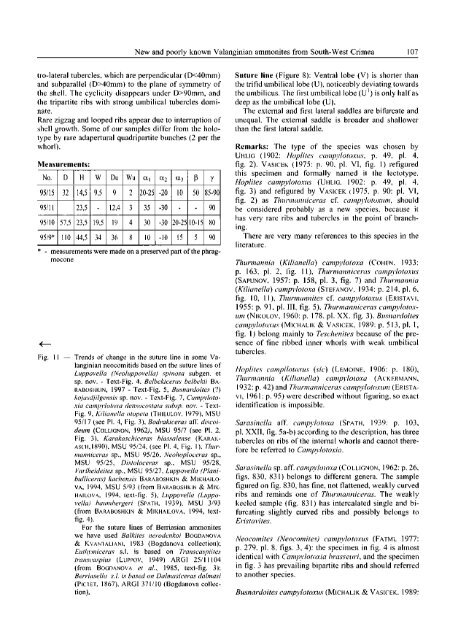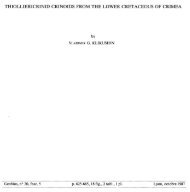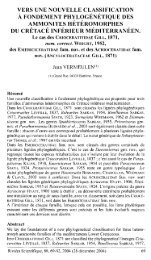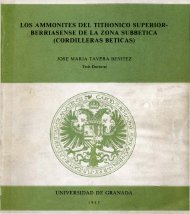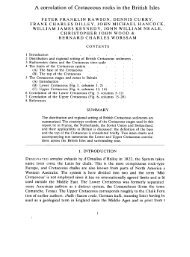New and poorly known Valanginian ammonites from South-West ...
New and poorly known Valanginian ammonites from South-West ...
New and poorly known Valanginian ammonites from South-West ...
Create successful ePaper yourself
Turn your PDF publications into a flip-book with our unique Google optimized e-Paper software.
<strong>New</strong> <strong>and</strong> <strong>poorly</strong> <strong>known</strong> <strong>Valanginian</strong> <strong>ammonites</strong> <strong>from</strong> <strong>South</strong>-<strong>West</strong> Crimea 107iro-lateral tubercles, which are perpendicular (D40mm) to the plane of symmetry ofthe shell. The cyclicity disappears under D>90mm, <strong>and</strong>the tripartite ribs with strong umbilical tubercles dominate.Rare zigzag <strong>and</strong> looped ribs appear due to interruption ofshell growth. Some of our samples differ <strong>from</strong> the holotypeby rare adapertural quadripartite bunches (2 per thewhorl).Measurements:ANo. D H W Du Wu Ia2 a.1 P Y95/15 32 14,5 9.5 9 2 20-25 -20 10 50 85-9095/11 23,5 - 12,4 3 35 -30 - - 9095/10 57.5 23,5 19,5 19 4 30 -30 20-25 10-15 8095/9* 110 44,5 34 36 8 10 -10 15 5 90* - measurements were made on a preserved part of the phragmoconeFig. 11 — Trends of change in the suture line in some <strong>Valanginian</strong>neocomitids based on the suture lines ofLuppovella (Neoluppovella) spinosa subgen. etsp. nov. - Text-Fig. 4. Belbekiceras belbekii BARABOSHKIN, 1997 - Text-Fig, 5, Busnardoites (?)kojasdjilgensis sp. nov. - Text-Fig. 7, Campylotoxiacampylotoxa densocostata subsp. nov. - Text-Fig. 9, Kilianella otopeta (THIEULOY. 1979), MSU95/1 7 (see PI. 4, Fig. 3). Bodrakiceras aff. discoideum(COLLIGNON, 1962;, MSU 95/7 (see PL 2.Fig. 3), Karakaschiceras biassalense (KARAK-ASCH.1890). MSU 95/24, (see PI. 4, Fig. 1), Thurmannicerassp., MSU 95/26. Neoboploeeras sp.,MSU 95/25, Distoloceras sp., MSU 95/28.Varlheideites sp.. MSU 95/27, Luppovella (PlanibulTtceras)kachensis BARABOSHKIN & MIKHAILOVA. 1994. MSU 5/93 (<strong>from</strong> BARABOSHKIN & MIK-HAILOV^, 1994. lexi-fig. 5), Luppovella (Luppovella)baumbergeri (SPATH. 1939). MSU 3/93(<strong>from</strong> BARABOSHKIN & MIKHAILOVA, 1994, textfig.4).For the suture lines of Bemasian <strong>ammonites</strong>we have used Balkites nerodenkoi BOGDANOVA& KVANIALIANI, 1983 (Bogdanova collection);Euthymiceras s,l, is based on Transcaspiitestranscaspius (LUPPOV, 1949) ARG1 25/11104(<strong>from</strong> Boo DA Nov A et a!., 1985, text-fig. 3):Berriasella s.l. is based on Dalmasiceras dalmasi(PICIET. 1867). ARGI 371/10 (Bogdanova collection).Suture line (Figure 8): Ventral lobe (V) is shorter thanthe trifid umbilical lobe (U), noticeably deviating towardsthe umbilicus. The first umbilical lobe (U 1 ) is only half asdeep as the umbilical lobe (U).The externa! <strong>and</strong> first lateral saddles are bifurcate <strong>and</strong>unequal. The external saddle is broader <strong>and</strong> shallowerthan the first lateral saddle.Remarks: The type of the species was chosen byUHLIG (1902; Hoplites campylotoxus, p, 49, pi. 4.fig. 2). VASICEK (1975: p. 90.' pi. VI, fig. 1) refiguredthis specimen <strong>and</strong> formally named it the lectotype.Hoplites campylotoxus (UHLIG, 1902: p. 49, pi. 4,fig. 3) <strong>and</strong> refigured by VASICEK (1975, p. 90: pi. VI,fig. 2) as Thurmanniceras cf. campylotoxum. shouldbe considered probably as a new species, because ithas very rare ribs <strong>and</strong> tubercles in the point of branching.There are very many references to this species in theliterature.Thurmannia (Kilianella) campylotoxa (COHEN. 1933:p. 163, pi. 2, fig. 11), Thurmanniceras campylotoxus(SAPUNOV. 1957: p. 158, pi. 3, fig. 7) <strong>and</strong> Thurmannia(Kilianella) campylotoxa (STEFANOV. 1934: p. 214. pi. 6,fig. 10, 11), Thurmannites cf. campylotoxus (ERISTAVI,1955: p. 91, pi. Ill, fig. 5), Thurmanniceras campylotoxum(NKOLOV. 1960: p. 178. pi. XX. fig. 3). Busnardoitescampylotoxus (MICHALIK & VASICEK, 1989: p. 513, pi, 1,fig. 1) belong mainly to Teschenites because of the presenceof tine ribbed inner whorls with weak umbilicaltubercles.Hoplites campilotoxus (sic) (LEMOINE, 1906: p. 180),Thurmannia (Kilianella) campylotoxa ( ACKFRMANN,1932; p. 42) <strong>and</strong> Thurmanniceras campylotoxum (ERISTAVI, 1961: p. 95) were described without figuring, so exactidentification is impossible.Sarasinella aff. campylotoxa (SPATH, 1939: p. 103,pi, XXII, fig. 5a-b) according to the description, has threetubercles on ribs of the interna! whorls <strong>and</strong> cannot thereforebe referred to Campylotoxia.Sarasinella sp. aff. campylotoxa (COLLIGNON, 1962: p. 26.figs, 830, 831) belongs to different genera. The samplefigured on fig. 830, has fine, not flattened, weakly curvedribs <strong>and</strong> reminds one of Thurmanniceras. The weaklykeeled sample (fig. 831) has intercalated single <strong>and</strong> bifurcatingslightly curved ribs <strong>and</strong> possibly belongs toEristavites.Neocomites (Neocomites) campylotoxus (FATMI. 1977:p. 279. pi. 8. figs. 3, 4): the specimen in fig. 4 is almostidentical with Campylotoxia hrasseuri. <strong>and</strong> the specimenin fig. 3 has prevailing bipartite ribs <strong>and</strong> should referredto another species,Busnardoites campylotoxus (MICHALIK & VASICEK. 1989:


